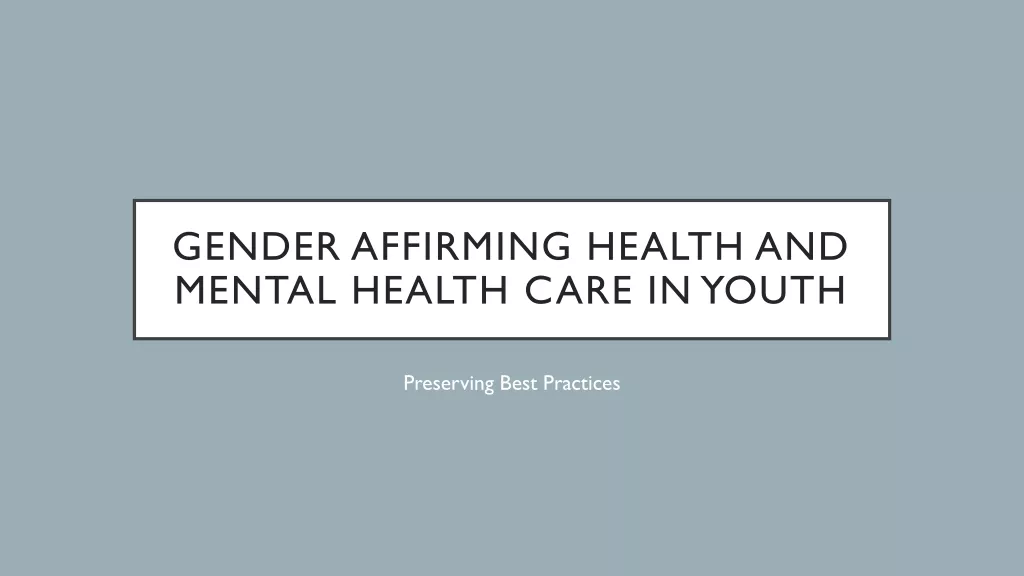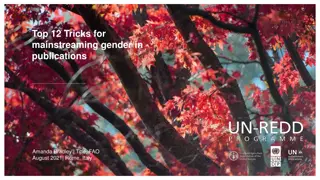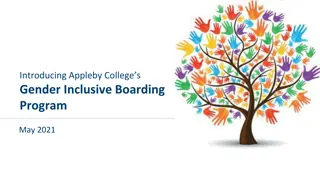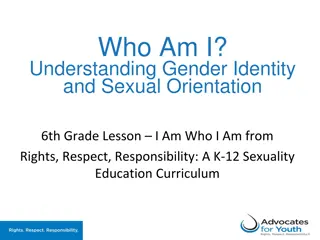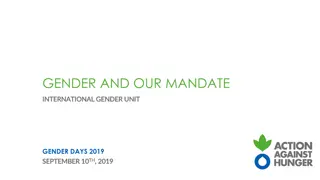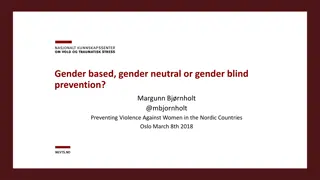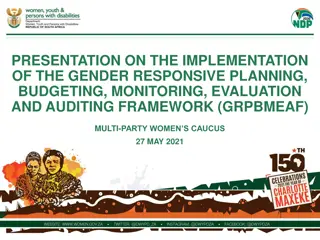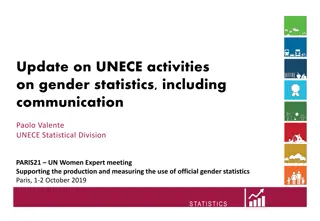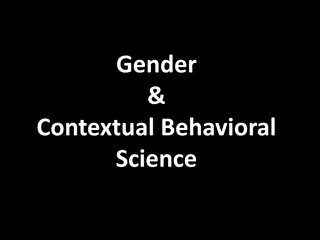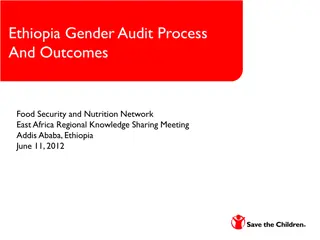Gender Diversity & Inclusive Communication
Learn about gender identity diversity, pronouns beyond traditional categories, the impact of misgendering individuals, and accessing resources for gender-inclusive communication. Discover the continuum of gender expressions and identities beyond the binary norm.
Download Presentation

Please find below an Image/Link to download the presentation.
The content on the website is provided AS IS for your information and personal use only. It may not be sold, licensed, or shared on other websites without obtaining consent from the author. Download presentation by click this link. If you encounter any issues during the download, it is possible that the publisher has removed the file from their server.
E N D
Presentation Transcript
Gender Inclusive Language & Pronouns
Presenter Nancy Jean Tubbs, MS Pronouns: she | her | hers Director, LGBT Resource Center University of California, Riverside nancy.tubbs@ucr.edu | 951-827-2267 out.ucr.edu
Topics Beyond the Binary Pronouns! Fear not the THEY Misgendering and how to avoid its negative impact Correspondence and Policy Inclusive Language UC Gender Recognition and Lived Name Policy Resources Q&A
Learning Objectives Learn the ways gender identity diversity is changing communication best practices Recognize pronouns beyond she and he Understand the negative impact of misgendering people Learn action items for gender inclusive communication Know how to access more resources
Gender & Sexuality Gender Gender Identity What your internal sense tells you that your gender is? How would you tell someone what your gender is? LEGAL GENDER: What is the legal gender on your docume nts, like driver s license/birth certificate? ASSIGNED AT BIRTH: What is the gender you were assigned at birth? Gender Expression How do you present yourself to society in clothing and mannerisms? Adapted from the National LGBT Health Education Center: A Program of the Fenway Institute www.lgbthealtheducation.org Sexual Orientation Who are you physically and emotionally attracted to? Who have you had intimate relationships with? How do you identify your sexuality?
Beyond the Binary Gender identity and expression are typically thought of in binary terms: Male and female, men and women, masculine and feminine Many transgender people fall on this binary: Trans women are women Trans men are men Some transgender people do not fall on this binary. They identify as nonbinary.
Continuum normative man normative woman Assigned Sex/Gender intersex male female Gender Identity nonbinary man woman Gender Expression androgynous masculine feminine Cisgender - gender identity aligns with sex/gender assigned at birth Transgender - gender identity transcends gender norms
Pronouns many options Nominative (subject) Objective (object) Possessive determiner Possessive Pronoun Reflexive Traditional pronouns His eyes gleam Her eyes gleam He likes himself She likes herself He He laughed I called him That is his She She laughed I called her That is hers Gender-inclusive pronouns Hir eyes gleam Their eyes gleam Ze likes hirself They like themselves Ze and hir Ze laughed I called hir That is hirs They They laughed I called them That is theirs
Misgendering & Its Impact Misgendering is mistaking or assuming peoples' pronouns without asking first Asking and correctly using someone's pronouns is one of the most basic ways to show your respect for their gender identity When you misgender someone unknowingly, the impact is more powerful than the intent If you make a mistake, apologize and move on, don t belabor the apology Then do better!
Misgendering & Its Impact When someone is referred to with the wrong pronoun, it can make them feel disrespected, invalidated, dismissed, and alienated It is a privilege to not have to worry about which pronoun someone is going to use for you based on how they perceive your gender Ongoing misgendering in the workplace may be interpreted as sexual harassment Using wrong pronouns after being informed of correct ones Using deadname instead of lived name
Inviting Pronouns Sharing When in a group during introductions model sharing pronouns and invite everyone to share, too One-on-one, try asking: The pronouns I use for myself are ___. What are your pronouns?" or "Which pronouns do you like to hear for yourself?" or "Can you remind me which pronouns you like for yourself?" It can feel awkward at first, but it is not half as awkward as getting it wrong or making a hurtful assumption Never guess someone s pronoun(s)
Correspondence Asking for Honorifics An honorific is a word or a title attached to a person's name in order to express respect. Common honorifics include Mr., Ms., and Dr. One gender neutral honorific is Mx. We cannot assume based on someone s name or perceived gender what honorific they use with their name. If you use honorifics in letter salutations, please ask individuals what honorific they use with their names when building contact lists. Letters of Recommendation If asked to write a reference ask them which pronoun(s) they want you to use in the letter, if any. The answer may be contextual for the audience of the letter.
UCOP Communications Guidelines In general, try to avoid using pronouns for third person singular by instead repeating the noun (use the employee instead of he or she, for example). You can also rework sentences to avoid using pronouns at all. 1. PPSM 23: The employee may add his or her own comments to accompany the performance appraisal form. 2. PPSM 30: A non-exempt employee must track all of the hours he/she worked s in each all of his/her positions and be paid overtime at the premium rate for all hours of actual work If the occasional they/their makes the most sense, that s okay too.
Inclusive Language - mypronouns.org Instead of yes, sir or thank you, ma am or other language that makes gender-based assumptions, you could simply communicate: Good morning! Thank you very much. It s a pleasure. How can I be of assistance today? Could I help the next guest? Yes, please. Yes, absolutely. Coming right up.
Inclusive Language - mypronouns.org Instead of calling upon or remarking about a particular man or woman (who has not disclosed that identity), you could indicate: The person in the red shirt The person with their hand raised The person who just spoke The person over here (gesturing)
Inclusive Language - mypronouns.org Instead of ladies and gentlemen or boys and girls or other language that assumes only two genders, you could use: Friends Colleagues Friends and colleagues Esteemed guests Children / Youngsters Students
UC Gender Recognition and Lived Name Policy In response to CA Gender Recognition Act that adds Nonbinary to gender options Female and Male on birth certificates, CA Drivers Licenses, and CA State IDs. The policy applies to both employees and students. The University is no longer asking for sex assigned at birth or sex as listed on birth certificate. The policy addresses how to report gender data to health insurers and the federal government and other places where only a F/M binary is used.
UC Gender Recognition and Lived Name Policy cont d The policy permits the use of lived student names on eligible academic documents which include transcripts, diplomas and dissertation title pages. The policy also expands sexual orientation options on the UC Admissions application. The policy states campuses may choose to add Pronouns fields in information systems. Deadline for compliance is December 31, 2023.
Be a Role Model Role model sharing pronouns in Zoom display names Role model sharing pronouns in e-mail signatures Role model sharing your pronouns when introducing yourself and invite others to share their pronouns Respect pronouns at all times
Resources MYPRONOUNS.ORG Resources on personal pronouns https://www.mypronouns.org Pronouns Matter https://out.ucr.edu/pronouns-matter Gender Inclusive Pronouns Tip Sheet https://chancellor.ucr.edu/sites/g/files/rcwecm761/files/202 0-08/Gender_Inclusive_Pronouns.pdf Gender Inclusive Forms Tip Sheet https://chancellor.ucr.edu/sites/g/files/rcwecm761/files/202 0-08/Gender_Inclusive_Forms.pdf UC Policy on Gender Recognition and Lived Name https://ucnet.universityofcalifornia.edu/news/2020/11/presi dent-drake-announces-new-presidential-policy-on-gender- recognition-and-lived-name.html
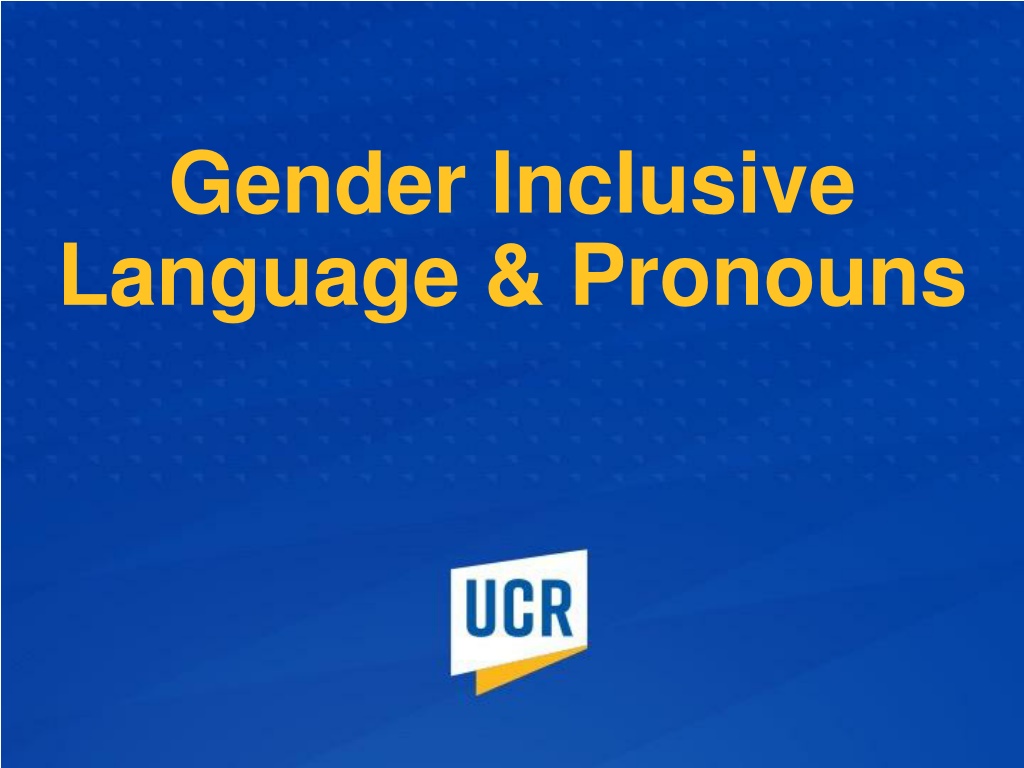
 undefined
undefined





